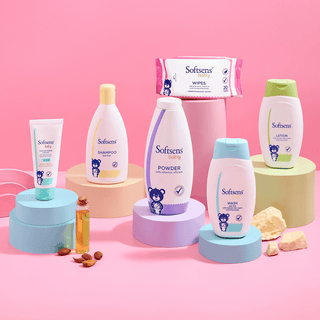
Introducing solid foods in your baby’s diet is an important step and will play a big role in shaping your little one’s food preferences in the long run. In this article, we’re going to cover everything from when you should start your baby on solid foods, to an age-wise baby food guide, and tips on how to help them adjust to this transition.
For more tips, you can also read 13 Baby Food Basics that every parent should know, and Weaning your Baby: What, When and How?
When is the best time to start introducing your baby to solid foods?
Although most experts suggest that you can start introducing solid foods to your baby sometime between 4 to 6 months of age, it mainly depends on your child’s developmental growth and can thus differ from one child to another. However, here are some basic signs that’ll help you know when the time is right:
-
When your baby can sit upright and hold her head up without any assistance
Can your baby sit properly in her highchair and hold her head up on her own? This is a major sign that your baby is ready to begin eating solid foods. If your baby hasn’t reached this stage yet, introducing solids can be dangerous and could possibly cause choking.
-
Your baby can accept food from a spoon and move it to the back of her throat without thrusting it forward with the tongue
Babies develop a tongue-thrust reflex while breastfeeding which makes them push food to the front of the mouth using their tongues. This reflex goes away over time. When your baby starts eating solid foods, it’s important for them to be able to transfer that food with their tongues to the back of their mouth.
-
Baby seems interested in new foods
If your baby is showing interest on her own, it’s a great time to introduce her to new foods, as long as she has also passed the above developmental milestones. An interested and curious baby is more likely to be open to trying and accepting new foods.
How long should you continue Breastmilk/Formula?
Even though you can start feeding baby solid foods around the 4-month mark, your baby will still receive most of her nutritional requirements from breastmilk or formula at this stage. Over time, this will change but you can continue giving your baby breastmilk/formula until 1 year of age. However, at the beginning, solid foods are only supplemental to breastmilk/formula. The idea of introducing baby food early on is so that your baby can slowly get accustomed to different tastes/textures and develop her food preferences.
Between 4-9 months, you can continue to give baby a recommended amount of 20-28 ounces of breastmilk or formula daily. From 9-12 months of age, you can give her 16-24 ounces of breastmilk or formula daily.
Useful Tips on Introducing your Baby to Solid Foods
Before we get into a month-by-month account on what kind of solids to offer your baby, here are some tips that might help make the process a little easier:
-
Get your baby ready for mealtime. Place her in a highchair with a comfortable, secure strap and put on a bib. Make sure you feed baby with a spoon right from the start. As you progress, let your baby hold the spoon and try to feed herself. Of course, this is going to be quite a messy process but it’s the best way to encourage her to eat well.
-
Take time in between introducing new ingredients. Remember – these are all brand new tastes and textures for your baby so give her time to get accustomed to them. Keep a space of 2-5 days between introducing new ingredients.
-
If your baby refuses a certain food, try again after a while. It’s funny but a your little one may hate a certain food one week and may actually love it the week after. So, don’t be disheartened if your baby rejects certain foods. Simply wait a bit and then try again. Sometimes, you might have to repeat this process 4-5 times before your baby accepts the food.
-
It’s perfectly fine to allow your little one to play around with her food. Sure, it can be a little frustrating but it’s a great way to help her learn about the food she is eating and to enjoy it.
-
Set fixed times for meals. Once your baby has started eating solids, set proper mealtimes and let her get used to this new schedule.
-
Maintain a food log. Writing down what your baby is eating and at what times will help you pinpoint any kind of food allergies or aversions, if your baby has any.
- Don’t stress over HOW MUCH your food baby is eating. Just like adults, some babies eat less and some eat more. All that matters is that you’re satisfied your baby is getting the nutrition she needs.
An Age-Wise Guide to Introducing Solid Foods
Although not all parents follow the same order when it comes to introducing solid foods to their babies, here’s our recommended list of solids your baby can eat as she grows, right from 4-month-old baby food to 1-year-old baby food.
At 4-6 months
You can introduce baby’s first foods at 4-6 months.
-
Iron-fortified Single-grain Baby Cereal
This is the most common first food for babies. At first, mix together 1 tsp of cereal with 4-5 tsp of breastmilk or formula. This should give you a smooth, liquid-like texture and is easier for your baby to eat. As your baby gets used to it, you can slowly start increasing the amount of cereal and making it thicker. At this stage, it is okay to give your baby around 1 tbsp of cereal mixed with breastmilk or formula, twice a day. Never feed baby cereal in a bottle. Always dish it out and feed with a spoon.
-
Single-ingredient Pureed Fruits & Vegetables
You can also start introducing your baby to certain pureed fruits & vegetables. (Scroll down for a full list of age-appropriate fruits & vegetables). Start by giving her 1 tbsp in a day and then slowly increase this to twice a day. Make sure it is pureed well so that your baby can easily eat it. Whenever you introduce a new ingredient, give it some time and wait for a few days before introducing another one. With fruits and vegetables, you should remove the skin and seeds, boil and cook well before making the puree. Do not add any sugar or salt.
-
Pureed meats
You can also give your baby a taste of pureed meats such as chicken or turkey. Simply make sure it is cooked well and pureed to a really thin consistency.
At 6-8 months
-
Iron-fortified Single-grain Baby Cereal
You can increase the amount of cereal to 2-3 tbsp served three times a day.
-
Pureed/Strained Fruits & Vegetables
Once your baby gets used to all these new textures, you can start thickening the consistency by straining the fruits and vegetables. Feed your baby around 2-3 tbsp of pureed fruits or vegetables twice a day.
-
Pureed Meats and Pureed Legumes
Make sure your baby is getting a good amount of proteins at this age, through pureed meats and legumes. You can also introduce more meats such as beef, pork and lamb. Serve your little one 1-2 tbsp of meats or legumes twice a day.
At 8-10 months
-
Iron-fortified Single-grain Baby Cereal
You can up the amount to about ½ a cup of cereal, spread over three meals.
-
Mashed Fruits & Vegetables
Your little one is now chewing better and can thus eat vegetables and fruits that are mashed. Serve up to ¾ cup of fruits and ¾ cup of vegetables daily, spread across three meals.
-
Pureed Meats and Pureed Legumes
Serve your little one 4-5 tbsp of meats or legumes twice a day.
-
Finger Foods
At 8-10 months, your baby will most likely be able to hold small foods between the thumb and forefinger. Give them small, easy-to-chew finger foods such as omelettes, crackers, potatoes, cheese etc.
At 10-12 months
-
Iron-fortified Single-grain Baby Cereal
½ a cup of cereal, spread over three meals.
-
Combination-foods
At 10-12 months, start giving your baby combinations of 2 different foods that your baby has already tried such as apple + spinach puree, pasta and chicken, and so on.
-
Soft, bite-sized vegetables and fruits
Continue with the same portions, but now let your baby experiment with eating vegetables and fruits that are cut up into tiny pieces and are soft enough to easily chew.
-
Protein-rich foods
Feed baby 4-5 tbsp of foods that are rich in proteins twice a day, including fish and lentils.
- Finger Foods Continue experimenting with finger foods and serve as snacks twice a day.
Here are some great healthy baby food recipes to help you get started.
For easier reference, here’s a baby food chart of all the recommended solid foods you can serve your baby as per her age!

Here are some more baby food guidelines before you get started:
-
Babies should not be given honey or cow’s milk before 1 year of age. Honey can cause infant botulism. Cow’s milk isn’t easily digested by babies and does not have the nutritional benefits your child requires.
-
Stay away from juice as it does not add any nutritional value to your baby’s diet and can lead to tooth decay or other issues. Instead serve your baby lots of fresh fruits.
-
Even though your baby is getting enough hydration from breastmilk/formula, you can offer your water in a small cup to sip on after meals. However, don’t give your baby water until she is at least six months old.
- Experts recommend introducing your child to allergenic foods such as fish, eggs and peanuts (in the age-appropriate texture and form) early on to help reduce any food sensitivities. However, always be careful and aware while introducing allergenic foods and look out for any possible reactions. If you are already aware of any family history of food-related allergies, consult your doctor before offering them to your baby.
The process of introducing your baby to solid foods can be very exciting and can truly help influence your child’s food preferences for years to come. Experiment, encourage and simply enjoy the journey!



















